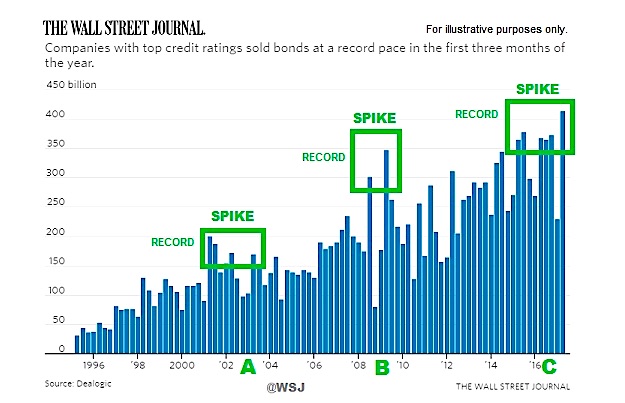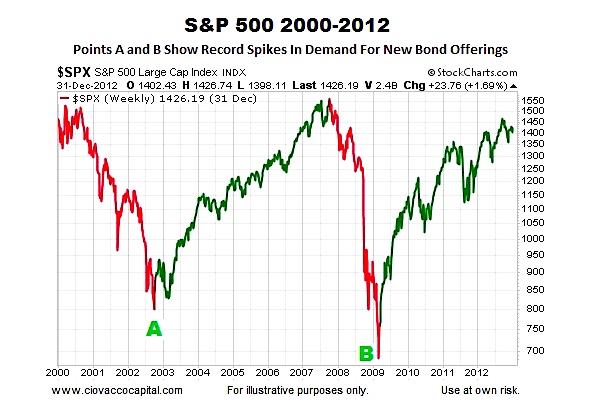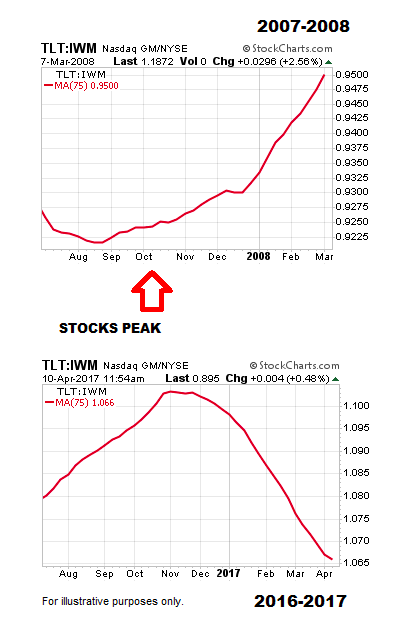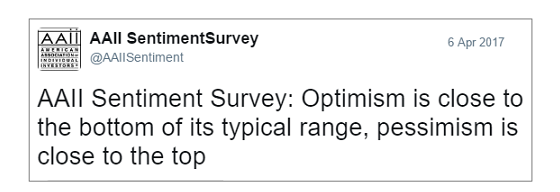Is The Trump Trade Overcrowded And On The Ropes?
Given the Trump trade is based on expectations for reduced regulation, lower taxes, and faster economic growth, if investors had moved all their chips to the Trump table, we would expect strong outflows in defensive-oriented bonds over the past several months. According to The Wall Street Journal, skeptical investors are racing toward bonds at a record pace:
Investors are buying record volumes of new bonds, signaling that many remain skeptical about the prospects for faster economic growth and are reluctant to move on from a strategy that has worked for years… The strong appetite for bonds shows how hard it is for investors to shake the assumption that the economy can do any better than muddle along as it has for years, with U.S. real gross domestic product growing less than 3% a year.
What Can We Learn From Similar Bond Binges?
As shown via the green annotations added to The Wall Street Journal image below, two other periods that featured a cluster of record high spikes in bond sales were near points A (October 2002) and B (March 2009).

The S&P 500 (NYSEARCA:SPY) chart below shows the same points A and B in The Wall Street Journal chart above. The spikes in demand for new bond offerings (A and B) coincided with two of the best buying opportunities in the stock market over the past 20 years. Therefore, it is difficult to draw any bearish conclusions about stocks based on the recent surge in demand in the primary fixed-income market.
Is The Trump Trade Alive And Well Or On The Ropes?
This week’s video uses facts, rather than opinions, to examine the health of the stock market (NYSEARCA:VTI) and Trump trade (NYSEARCA:SPHB). After reviewing the facts, you can make your own call.
Are Trends Flipping In Favor Of Bonds?
When fear dominates the entire investment landscape, investors begin to migrate toward more defensive assets, as they did in late 2007. Notice in the top portion of the image below, defensive-oriented bonds (NASDAQ:TLT) started to gain significant traction relative to growth-oriented small caps (NYSEARCA:IWM) several months before the S&P 500 peaked (red arrow). The same bond:small cap ratio on April 10, 2017 shows a trend that continues to favor small caps relative to bonds. The look of the chart below may change, but it has not changed yet.
Are Investors Overly Optimistic?
When investor sentiment hits extreme levels, it can be a contrary indicator for stocks. Are investors sending alarming euphoric signals in 2017? Not according to the latest American Association of Individual Investors Sentiment Survey (AAII).
Going back to 1987, the average percentage of bullish respondents is 38.5%; today the figure sits well below at 28.3%. Rather than being well below average, the present-day percentage of bearish responses is well above average; 39.6% bears today vs. the historical average of 30.5% bears. These figures are more in line with fear rather than complacency.
Thanks for reading.
Read more from Chris over on CCM.
Twitter: @CiovaccoCapital
The author or his clients may hold positions in mentioned securities at the time of publication. Any opinions expressed herein are solely those of the author, and do not in any way represent the views or opinions of any other person or entity.











